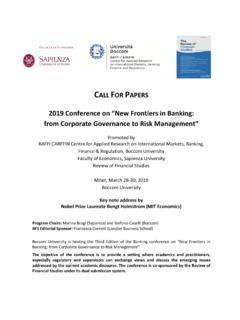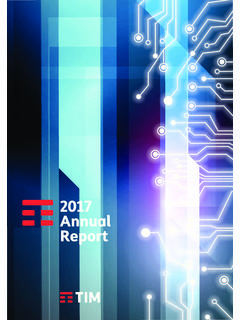Transcription of BIS Working Papers
1 BIS Working Papers No 685 Why so low for so long? A long-term view of real interest rates by Claudio Borio, Piti Disyatat, Mikael Juselius and Phurichai Rungcharoenkitkul Monetary and Economic Department December 2017 JEL classification: E32, E40, E44, E50, E52. Keywords: Real interest rate, natural interest rate, saving, investment, inflation, monetary policy. BIS Working Papers are written by members of the Monetary and Economic Department of the Bank for International Settlements, and from time to time by other economists, and are published by the Bank. The Papers are on subjects of topical interest and are technical in character. The views expressed in them are those of their authors and not necessarily the views of the BIS. This publication is available on the BIS website ( ). Bank for International Settlements 2017. All rights reserved. Brief excerpts may be reproduced or translated provided the source is stated.
2 ISSN 1020-0959 (print) ISSN 1682-7678 ( online) Why so low for so long? A long-term view of real interest rates Claudio Borio, Piti Disyatat, Mikael Juselius and Phurichai Rungcharoenkitkul 2 December 2017 Abstract Prevailing explanations of the decline in real interest rates since the early 1980s are premised on the notion that real interest rates are driven by variations in desired saving and investment. But based on data stretching back to 1870 for 19 countries, our systematic analysis casts doubt on this view. The link between real interest rates and saving-investment determinants appears tenuous. While it is possible to find some relationships consistent with the theory in some periods, particularly over the last 30 years, they do not survive over the extended sample. This holds both at the national and global level. By contrast, we find evidence that persistent shifts in real interest rates coincide with changes in monetary regimes.
3 Moreover, external influences on countries real interest rates appear to reflect idiosyncratic variations in interest rates of countries that dominate global monetary and financial conditions rather than common movements in global saving and investment. All this points to an underrated role of monetary policy in determining real interest rates over long horizons. JEL classification: E32, E40, E44, E50, E52. Keywords: Real interest rate, natural interest rate, saving, investment, inflation, monetary policy. We would like to thank I aki Aldasoro, Marco Buti and colleagues, Stijn Claessens, Andy Filardo, Marc Flandreau,Joseph Gagnon, Gaston Gelos, Charles Goodhart, James Hamilton, Esa Jokivuolle, David Laidler, Enrique Mart nez-Garc a, Luis Brandao Marques, Elmar Mertens, Emanuel M nch, Francisco Nadal de Simone, Edward Nelson,Lukasz Rachel, Umang Rawat, Daniel Rees, Larry Schembri, Hyun Song Shin, Nathan Sussman, Alan Taylor, KostasTsatsaronis, Gregory Thwaites and BIS seminar participants for helpful comments and discussions.
4 Amy Wood,Diego Urbina and Giulio Cornelli provided excellent statistical assistance. All remaining errors are ours. The viewsexpressed are those of the authors and do not necessarily represent those of the Bank for InternationalSettlements, Bank of Finland or the Bank of Thailand. Rungcharoenkitkul (corresponding author), Senior Economist, Bank for International Juselius: Senior Research Economist, Bank of Finland, Borio: Head of Monetary and Economic Department, Bank for International Settlements, Executive Director, Puey Ungphakorn Institute for Economic Research, Bank of Thailand, Table of contents Introduction .. 1 1. Real interest rate determination: an overview of 2 2. Real interest rate determination: the role of real factors .. 6 Essential elements of the empirical strategy .. 6 Data and definition of variables .. 8 A first look at the data.
5 10 Tests and main results .. 12 3. Real interest rate determination: the role of monetary factors .. 21 Analytical considerations .. 21 Previous work .. 25 New evidence on monetary policy regimes .. 26 A monetary narrative of the evolution of real interest rates .. 34 Conclusion .. 36 References .. 38 Annex A: Data and plots .. 44 Data sources and coverage .. 44 Data plots of real interest rates .. 46 Saving-investment factors for the United States and United Kingdom .. 52 Annex B: Robustness results .. 53 Bivariate panel regression with time trends .. 53 Average dependent and independent variables .. 54 Short-term market rates as the dependent variable .. 56 Excluding periods after the world wars .. 60 Alternative expectations of inflation and GDP growth .. 61 Savers ratio as an independent variable .. 63 Time-varying retirement age interactions with demographic variables.
6 64 Productivity growth as an independent 65 Risk premium as an independent variable .. 66 WP685 Why so low for so long? A long view of real interest rate determination 1 Introduction Global real (inflation-adjusted) interest rates, short and long, have been on a downward trend throughout much of the past 30 years and have remained exceptionally low since the Great Financial Crisis (GFC). This has triggered a debate about the reasons for the decline. Invariably, the presumption is that the evolution of real interest rates reflects changes in underlying saving-investment determinants. These are seen to govern variations in some notional equilibrium or natural real rate, defined as the real interest rate that would prevail when actual output equals potential output, towards which market rates gravitate. The presumption that real interest rates are so anchored is evident in two broad analytical strands.
7 The first focuses on observed real interest rates and relates them directly to the evolution of the factors that underpin the economy s saving-investment balance (eg IMF (2014), Bean et al (2015), Council of Economic Advisers (2015)). One prominent variant is the hypothesis that persistently weak demand for capital, a rising propensity to save and lower trend growth have brought about an era of secular stagnation (Summers (2014, 2015)). Another variant argues that a higher propensity to save in emerging market economies (EMEs), coupled with investors growing preference for safe assets, has boosted the supply of saving worldwide (Bernanke (2005), Broadbent (2014), Caballero et al (2008)). Most recently, demographic changes have been singled out (Carvalho et al (2016), Gagnon et al (2016), Rachel and Smith (2017)). This strand typically does not consider inflation explicitly and links real interest rates directly to the posited real-sector determinants.
8 In effect, it assumes that over the relevant horizon the observed (market) rate and the unobserved natural rate coincide. The second strand focuses on the equilibrium or natural real rate, estimated as an unobserved variable in a filtering system (eg Laubach and Williams (2015), Justiniano and Primiceri (2010)). Typically, the natural rate is anchored to theory-prescribed variables, such as potential growth and household preferences, which are themselves unobserved, and inflation plays a critical role in pinning down the natural rate alongside the other latent system variables. In Laubach and Williams (2003), for example, rising inflation indicates that output is above potential and, correspondingly, that the actual interest rate is below the natural rate; falling inflation indicates the reverse. These reflect the well known Phillips-curve and aggregate-demand (IS) relationships that lie at the core of standard macroeconomic models.
9 Both strands share a couple of limitations. The bulk of the analysis examines the period since the mid-1980s, when real interest rates have been declining. And neither tests directly the hypotheses that the postulated saving-investment framework and/or the postulated inflation determination process adequately characterise the data. These are regarded as maintained hypotheses, be it in the underlying narrative and calibration of structural models or in the filtering systems. There is little by way of direct estimation that tests the link between observable variables, such as demographics, and real interest rates. Notable exceptions are Hamilton et al (2015) and Lunsford and West (2017), who consider some such variables over longer periods. We aim to fill this gap by systematically examining the empirical link between real interest rates and the posited determinants, not just since the 1980s but also back in history.
10 Based on data starting in the 19th century for 19 economies, we find only a tenuous link between real interest rates and observable proxies for the main saving-investment determinants. Some variables, notably demographics, do exhibit the expected relationship with real interest rates 2 WP685 Why so low for so long? A long view of real interest rate determination in some subsamples, especially in the more recent one. But there is little evidence of a stable relationship across subsamples. This applies to both domestic and global variables. Going beyond the standard factors, we investigate whether monetary policy has persistent effects on real interest rates. In our long sample, monetary policy regimes, such as the gold standard, Bretton Woods and inflation targeting, go hand-in-hand with significant shifts in real interest rates. At a global level, we find that the influence of external factors on countries real interest rates reflects the importance of the financially dominant countries role as global monetary anchors rather than common variations in global saving-investment determinants.














